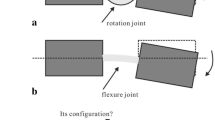Abstract
The design of compliant hinges has been extensively studied in the size and shape level in the literature. This paper presents a method for designing the single-axis flexure hinges in the topology level. Two kinds of hinges, that is, the translational hinge and the revolute hinge, are studied. The basic optimization models are developed for topology optimization of the translational hinge and the revolute hinge, respectively. The objective for topology optimization of flexure hinges is to maximize the compliance in the desired direction meanwhile minimizing the compliances in the other directions. The constraints for accomplishing the translational and revolute requirements are developed. The popular Solid Isotropic Material with Penalization method is used to find the optimal flexure hinge topology within a given design domain. Numerical results are performed to illustrate the validity of the proposed method.
Similar content being viewed by others
References
Howell L L. Compliant Mechanisms. New York: John Wiley & Sons, 2001
Wang H, Zhang X. Input coupling analysis and optimal design of a 3-dof compliant micro-positioning stage. Mech Mach Theroy, 2008, 43: 400–410
Fatikow S. Automated Nanohandling by Microrobots. 1st ed. London: Springer, 2007
Bendsøe M P, Sigmund O. Topology Optimization: Theory, Methods and Applications. Berlin: Springer, 2003
Zhu B L, Zhang X M. A new level set method for topology optimization of distributed compliant mechanisms. Int J Numer Meth Eng, 2012, 91: 843–871
Zhu B L, Zhang X M, Wang N F. Topology optimization of hinge-free compliant mechanisms with multiple outputs using level set method. Struct Multidisc Optim, 2013, 47: 659–672
Lobontiu N. Compliant mechanisms: Design of flexure hinges. CRC Press, 2003
Tian Y, Shirinzadeh B, Zhang D, et al. Three flexure hinges for compliant mechanism designs based on dimensionless graph analysis. Precis Eng, 2010, 34: 92–100
Paros J M, Weisbord L. How to design flexure hinges. Mach Des, 1965, 37: 151–156
Smith S T, Badami V G, Dale J S, et al. Elliptical flexure hinges. Rev Sci Instrum, 1997, 68: 1474–1483
Lobontiu N, Paine J S N, Garcia E, et al. Corner-filleted flexure hinges. J Mech Design, 2001, 123: 346–352
Lobontiu N, Paine J S, Garcia E, et al. Design of symmetric conic-section flexure hinges based on closed-form compliance equations. Mech Mach Theory, 2002, 37: 477–498
Lobontiu N, Paine J S, O’Malley E, et al. Parabolic and hyperbolic flexure hinges: Flexibility, motion precision and stress characterization based on compliance closed-form equations. Precis Eng, 2002, 26: 183–192
Lobontiu N, Garcia E, Hardau M, et al. Stiffness characterization of corner-filleted flexure hinges. Rev Sci Instrum, 2002, 75: 4896–4905
Tseytlin Y M. Notch flexure hinges: An effective theory. Rev Sci Instrum, 2002, 73: 3363–3368
Awtar S, Slocum A H, Sevincer E. Characteristics of beam-based flexure modules. J Mech Design, 2007, 129: 625–639
Smith S T. Flexures: Elements of Elastic Mechanisms. New York: Gordon and Breach, 2000
Schotborgh W O, Kokkeler F G, Tragter H, et al. Dimensionless design graphs for flexure elements and a comparison between three flexure elements. Precis Eng, 2005, 29: 41–47
Bona F D, Munteanu M G. Optimized flexural hinges for compliant micromechanisms. Analog Integr Circ S, 2005, 44: 163–174
Zelenika S, Munteanu M G, Bona F D. Optimized flexural hinge shapes for microsystems and high-precision applications. Mech Mach Theory, 2009, 44: 1826–1839
Trease B P, Moon Y M, Kota S. Design of large-displacement compliant joints. J Mech Design, 2005, 127: 788–798
Yu J J, Li S Z, Su H J, et al. Screw theory based methodology for the deterministic type synthesis of flexure mechanisms. J Mech Robot, 2011, 3: 03100801–03100813
Su H J, Denis V, Dorozhkin et al. A screw theory approach for the conceptual design of flexible joints for compliant mechanisms. J Mech Robot, 2009, 1: 04100901–04100907
Hopkins J B, Culpepper M L. Synthesis of multi-degree of freedom, parallel flexure system concepts via freedom and constraint topology (FACT)-part I: Principles. Precis Eng, 2010, 34: 259–270
Frecker M I, Ananthasuresh G K, Nishiwaki S, et al. Topological synthesis of compliant mechanisms using multi-criteria optimization. J Mech Design, 1997, 119: 238–245
Sigmund O. On the desgn of compliant mechanisms using topology optimization. Mech Based Struct Mach, 1997, 25: 493–524
Nishiwaki S, Min S, Yoo J, et al. Optimal structural design considering flexibility. Comput Methods Appl Mech Eng, 2001, 190: 4457–4504
Wang M, Wang X M, Guo D M. A level set method for structural topology optimization. Comput Methods Appl Mech Eng, 2003, 192: 227–246
Allaire G, Jouve F, Toader A M. Structural optimization using sensitivity analysis and a level set method. J Comput Phys, 2004, 194: 363–393
Rozvany G I N. A critical review of established methods of structural topology optimization. Struct Multidisc Optim, 2009, 37: 217–237
Yu J J, Li S Z, Su H J, et al. Screw theory based methodology for the deterministic type synthesis of flexure mechanisms. J Mech Robot, 2011, 3: 031008
Choi K K, Kim N H. Structural sensitivity analysis and optimization 1: Linear system. New York: Springer-Verlag, 2005
Yong Y K, Lu T F, Handley D C. Review of circular flexure hinge design equations and derivation of empirical formulations. Precis Eng, 2008, 32: 63–70
Svanberg K. The method of moving asymptotes-a new method for structural optimization. Int J Numer Methods Eng, 1987, 24: 359–373
Barthelemy J F M, Haftka R T. Approximation concepts for optimum structural design-a review. Struct Multidisc Optim, 1993, 5: 129–144
Author information
Authors and Affiliations
Corresponding author
Rights and permissions
About this article
Cite this article
Zhu, B., Zhang, X. & Fatikow, S. Design of single-axis flexure hinges using continuum topology optimization method. Sci. China Technol. Sci. 57, 560–567 (2014). https://doi.org/10.1007/s11431-013-5446-4
Received:
Accepted:
Published:
Issue Date:
DOI: https://doi.org/10.1007/s11431-013-5446-4




